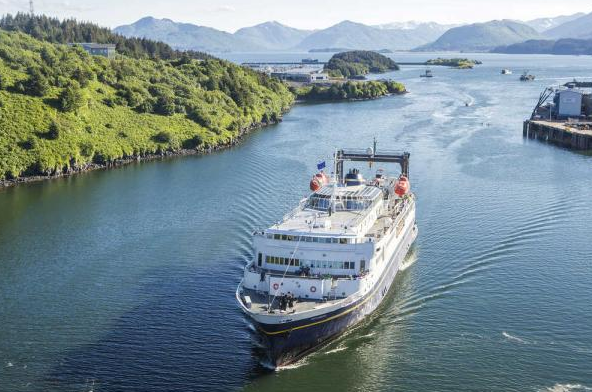The ferry Tustumena is safe to sail.
On Monday, the members of the Alaska Marine Transportation Advisory Board were presented with the results of an engineering survey analyzing the health of the 53-year-old ship that connects Kodiak and the Aleutians to the rest of the state.
“To make a long story short, in layman’s terms, that boat is sound,” Capt. John Falvey, general manager of the Alaska Marine Highway System, told members of the board.
In early 2016, Patrick Eberhardt of Coastwise Corp. — the sole naval architecture firm in Alaska — discovered several cracks in the Tustumena’s structure, likely caused by a rough January voyage across the Gulf of Alaska.
The cracks didn’t pose an immediate danger to the ship or its passengers, but Eberhardt feared that the ship was suffering from the repeated beatings of 53 years’ worth of North Pacific waves.
He recommended a handful of extraordinary measures, including that the Marine Highway “stop using the Tustumena for ‘Cross Gulf of Alaska’ trips,” keep the ship near shore and out of heavy seas.
Eberhardt also asked the ferry system to conduct a detailed analysis of the stresses on the ship and accelerate plans for a replacement vessel.
Following Eberhardt’s recommendations in May, the ferry system hired Elliot Bay Design Group, a marine architecture and engineering firm based in Seattle. In a letter dated Sept. 28 and addressed to the ferry system’s assistant engineering manager, engineer Matthew Wichgers concluded that the “cracking does not appear to be symptomatic of whole-hull structural deficiencies. There is no indication that the vessel is at risk of catastrophic structural failure in heavy seas.”
The analysis did find specific points where the Tustumena’s design focused stresses on particular ship components. In one place, inspectors from Elliott Bay found the Tustumena’s bottom deck plating had been distorted by stress.
Elliott Bay also found that some of the ship’s scantlings — its steel ribs — were smaller than normally allowed.
Overall, the Tustumena was found to exceed even modern requirements for hull strength, more than compensating for those undersized scantlings.
“The structure exceeds the (American Bureau of Shipping) requirement for whole-hull strength by a factor of 1.8,” Wichgers wrote.
Eberhardt said by phone that he had not seen the analysis and was disappointed that the ferry system excluded his company from the survey despite its request, but he is glad the Marine Highway went the needed mile to conduct such a survey.
Wichgers ended his report with a recommendation that the Marine Highway continue to inspect areas of stress aboard the Tustumena and analyze the ship for metal fatigue caused by 53 years of rough seas.
“Modifications to local structure may be needed to ensure that a satisfactory condition is maintained throughout the desired service life,” Wichgers concluded.
For the time being, said ferry system spokesman Jeremy Woodrow, the Tustumena will remain out of cross-Gulf service, and the ferry system intends to ask the Alaska Legislature this year to use a portion of its vessel replacement fund to begin construction of a new Tustumena.

